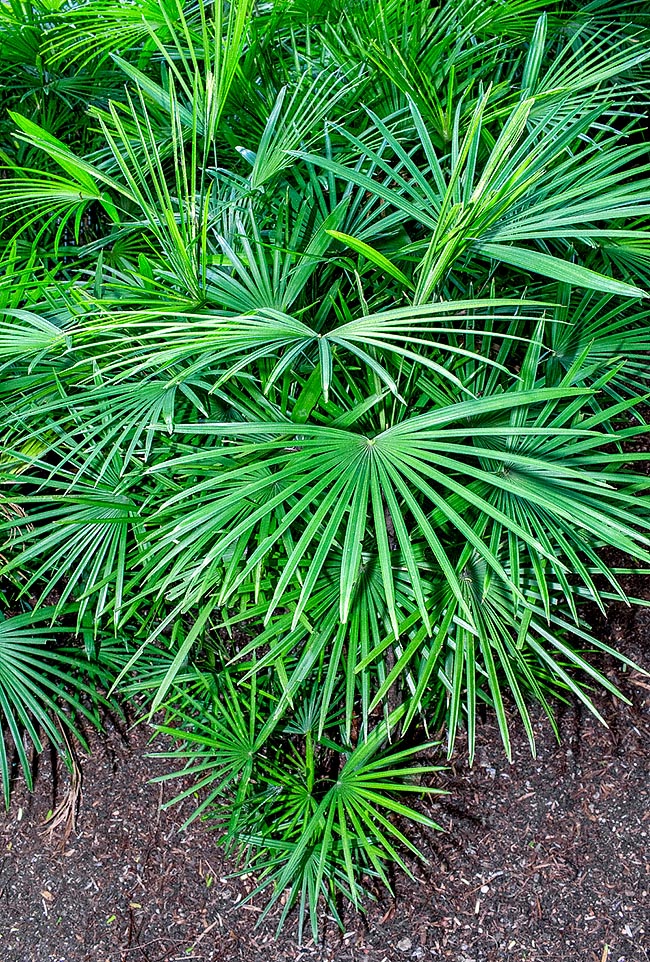Family : Arecaceae

Text © Alessandro Marini

English translation by Mario Beltramini
Rhapis multifida Burret is endemic to China (provinces of Guangxi and of Yunnan) and of the northern regions of Vietnam. It grows in the plain and mountain forests, on the rocky slopes, up to 1500 m of altitude.
The name of the genus Rhapis comes from the Greek term “rhapís”, stick, with reference to the thi, stems of this species, of reduced height if compared with most palms. The specific name multifida comes from the Latin terms “multus”, much, and “fendo”, to split, to divide, with reference to the numerous segments of the leaves.
Common names: Jade Empress palm, Finger palm, Guangxi fan palm, Jade palm, Lady Finger Palm, Finger Lady Palm (English).
Rhapis multifida is a multistemmed species with dense tufts, up to 3 m broad, reaching the 2,5 m of height. The thin stems, resembling small bamboo canes; with a diameter of up to 2,5 cm, are covered by brown, tight, fibres and are arranged diagonally. In the older plants detach with the time, showing the smooth surface of the stem, having a nice bright green colour.

Native to China and Vietnam, Rhapis multifida is ideal for small gardens with few rivals as indoor palm © G. Mazza
The leaves are palmate, circular, up to 60 cm broad. The lamina is incised for above two thirds by coriaceous segments, thin, usually 15 but often more numerous. They are of dark green colour, even 45 cm long, with pointed apices and toothed margin. The central segment and the two adjacent are wider than the other segments. The petiole is smooth, up to 40 cm long and 4 mm broad.
Rhapis multifida is a dioecious species, that is, with plants bearing only male or female flowers. The inflorescences generate among the leaves, protected by tubular bracts covered by fibres. Up to 40 cm long, they are ramified, usually on 2 pr 3 orders, and those of the secondary order form a right angle in respect to those of the first. The ovoidal fruits, about 8 mm long, are carried by a petiole that may reach 5 mm.
Rhapis multifida is quite similar to Rhapis humilis and for long it has been considered as a variety of the latter. It distinguishes for the thinner stems and the foliar segments undivided at the base, more numerous and with pointed apices. At first sight could even be mistaken with Rhapis excelsa of greater height, but it carries a larger number of foliar segments, thin, drooping and of a paler colour. The crown is characterized by a lower number of leaves and consequently looks much more open. Furthermore, in Rhapis excelsa the stems do not lose the brown fibres and so the stem is not smooth and green.
Rhapis multifida is considered as the most elegant species of the genus and consequently is very sought for by the collectors. Due to its contained size, it is the ideal plant for small gardens and has few competitors as indoor palm because it contents of little light, and tolerates the thermal changes and relatively low humidity values. Furthermore, it has a slow rate of growth and therefore can be cultivated in pots.
It adapts to different typologies of substratum, even if it prefers the neutral or acidic soils, rich in organic matter. However, it does not stand the drought and if it does not get adequate watering, tends to languish, especially during the dry season. The soil must never be completely dry between the waterings, but it is important to avoid water stagnations as these cause the onset of fungi of the genus Phytophthora.
It can be damaged by the winds that dry up the leaves completely, and in order to grow well it needs a high level of air humidity. It does not stand the exposition in full sun, in particular in the arid climates, and prefers positions of half shade or of total shade, in any case indispensable for the development of the young plants. It can stand only a few hours per day of direct sun, provided an abundant availability of water, and in this case, the crown and the stems in the sun get bigger.
It is cultivated especially in the tropical and subtropical climates, but is rather resistant to cold, tolerating occasionally, for short periods, temperatures of -2, -3 °C. For a good cultivation the lowest temperatures should never, in any case, drop below zero. It propagates by seed, but it is easier to reproduce it by division of the rhizomes or through the suckers that emerge at the base of the plants.
